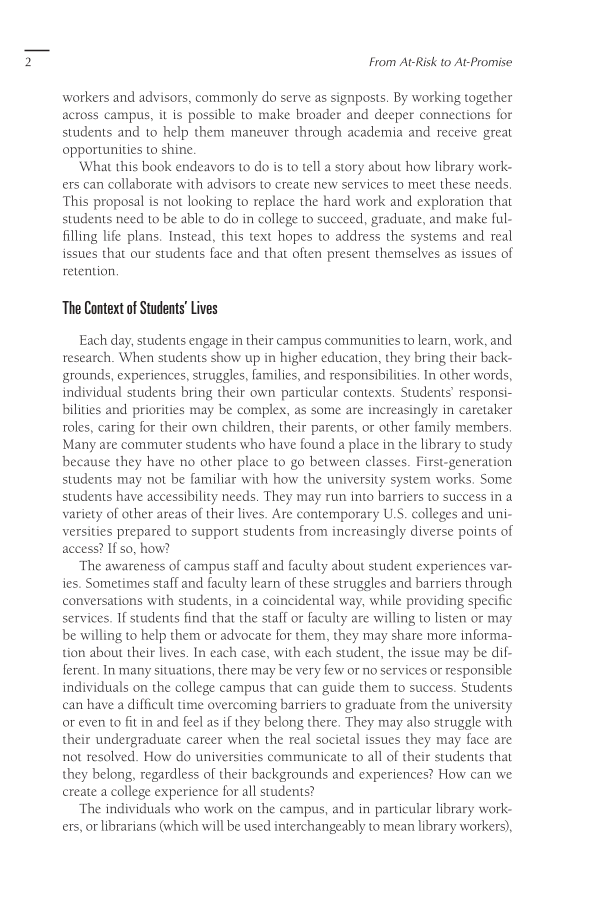2 From At-Risk to At-Promise workers and advisors, commonly do serve as signposts. By working together across campus, it is possible to make broader and deeper connections for students and to help them maneuver through academia and receive great opportunities to shine. What this book endeavors to do is to tell a story about how library work- ers can collaborate with advisors to create new services to meet these needs. This proposal is not looking to replace the hard work and exploration that students need to be able to do in college to succeed, graduate, and make ful- filling life plans. Instead, this text hopes to address the systems and real issues that our students face and that often present themselves as issues of retention. The Context of Students’ Lives Each day, students engage in their campus communities to learn, work, and research. When students show up in higher education, they bring their back- grounds, experiences, struggles, families, and responsibilities. In other words, individual students bring their own particular contexts. Students’ responsi- bilities and priorities may be complex, as some are increasingly in caretaker roles, caring for their own children, their parents, or other family members. Many are commuter students who have found a place in the library to study because they have no other place to go between classes. First-generation students may not be familiar with how the university system works. Some students have accessibility needs. They may run into barriers to success in a variety of other areas of their lives. Are contemporary U.S. colleges and uni- versities prepared to support students from increasingly diverse points of access? If so, how? The awareness of campus staff and faculty about student experiences var- ies. Sometimes staff and faculty learn of these struggles and barriers through conversations with students, in a coincidental way, while providing specific services. If students find that the staff or faculty are willing to listen or may be willing to help them or advocate for them, they may share more informa- tion about their lives. In each case, with each student, the issue may be dif- ferent. In many situations, there may be very few or no services or responsible individuals on the college campus that can guide them to success. Students can have a difficult time overcoming barriers to graduate from the university or even to fit in and feel as if they belong there. They may also struggle with their undergraduate career when the real societal issues they may face are not resolved. How do universities communicate to all of their students that they belong, regardless of their backgrounds and experiences? How can we create a college experience for all students? The individuals who work on the campus, and in particular library work- ers, or librarians (which will be used interchangeably to mean library workers),
Document Details My Account Print multiple pages
Print
You have printed 0 times in the last 24 hours.
Your print count will reset on at .
You may print 0 more time(s) before then.
You may print a maximum of 0 pages at a time.


























































































































































